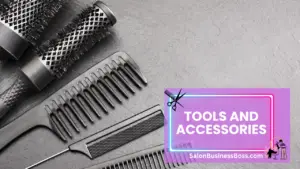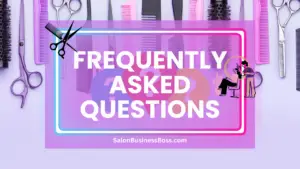Stepping into the world of entrepreneurship can be as invigorating as a fresh haircut. Just like crafting the perfect hairstyle requires a keen eye and skilled hands, starting up a hair salon demands careful consideration of costs, creativity, and commitment.
Here are some key considerations for starting a hair salon: location costs, licenses, equipment, staffing, branding, and unexpected expenses. Plan smart, style sharper.
In this article, we’re going to take a deep dive into the world of hair salon startup costs, from the essentials to the unexpected, so you can be well-prepared to embark on this exciting journey.
The Essentials: A Strong Foundation
Before you start snipping and styling, you’ll need a solid foundation. This includes finding the perfect location, obtaining the necessary licenses and permits, and decking out your salon with the essential equipment. Let’s break down these fundamental costs:
Location and Lease

Securing the right location is a critical initial step when starting your hair salon. The costs associated with this aspect can significantly vary based on your city and the specific neighborhood you’re eyeing. During your search for an ideal location, take into account factors like foot traffic, visibility, and the existing local competition. These elements can greatly impact the potential growth of your salon.
When it comes to leasing a space, you’ll typically encounter two main expenses. The first is the monthly rent, which varies depending on the location’s desirability and market rates. The second is a security deposit, a refundable upfront payment that acts as a safeguard for the property owner. It’s essential to carefully assess your budget to accommodate both these costs.
Choosing a strategic location isn’t just about affordability; it’s about positioning your salon where it can attract the right clientele. By understanding and accounting for these location and leasing expenses, you’ll be better equipped to embark on your hair salon venture with financial clarity and confidence.
Read more about: Grand Opening Ideas for Salon: Innovative Approaches to Try
Licenses and Permits
When setting up your hair salon, it’s important to adhere to legal requirements. This involves obtaining the necessary licenses and permits to operate your business within the bounds of the law. These licenses and permits serve as official approvals from relevant authorities that validate your salon’s legitimacy.
The licenses and permits you need typically include a business license, which grants you permission to run a business within your jurisdiction. Moreover, a cosmetology license is necessary, showing that you’re qualified to provide hair services. Health department permits are vital as well, indicating that your salon meets hygiene and safety standards.
Depending on your specific location and regulations, there might be additional permits required. These could relate to fire safety, building codes, or other local considerations. It’s crucial to thoroughly research and understand your local requirements to ensure you’re compliant with all necessary licenses and permits.
Incorporating these licenses and permits into your startup plan is a pivotal part of establishing your hair salon on solid legal footing. By doing so, you’ll avoid potential setbacks and ensure a smooth path for your business to thrive within the regulatory framework.
Salon Equipment
The core of your hair salon lies in its equipment – the essential tools that make your services possible. This equipment includes chairs for customers, mirrors for hairstyling checks, sinks for hair washing, hair dryers for drying, and an array of styling tools. These items collectively form the backbone of your salon operations.
The quality of your equipment directly impacts the experience your customers have. Investing thoughtfully in high-quality equipment can enhance customer satisfaction and contribute to your salon’s reputation. It’s not just about functionality; it’s about creating a comfortable and efficient environment for both clients and stylists.
Budgeting for equipment should extend beyond the initial purchase. Regular maintenance is key to keeping your equipment in optimal condition. Equipment can wear out over time, necessitating replacements. Allocating funds for these ongoing needs ensures the seamless continuity of your services without unexpected interruptions.
Staffing and Training: Stylists and Support
An effective salon is only as strong as its team. Hiring skilled stylists and support staff is crucial to building a reputable business. Let’s take a look at the costs associated with staffing and training:
Stylist Salaries

At the heart of your salon are your stylists – the individuals who craft the hairstyles and provide the services. Paying them competitive salaries is pivotal. It’s what keeps your salon running smoothly and your customers satisfied.
To determine the appropriate salary, take into account the standards prevalent in the hair industry within your local area. These standards can vary, so researching the typical pay range for stylists in your region is essential. By offering salaries that align with these standards, you make your salon an attractive workplace for experienced and skilled stylists.
Fair compensation not only attracts top talent but also encourages their loyalty. When stylists feel valued and fairly compensated, they’re more likely to stay with your salon long-term. This consistency benefits both your business and your clientele, as customers tend to form strong connections with familiar stylists.
Remember, your stylists are integral to the experience your salon offers. Providing competitive salaries is an investment in the quality of your services and the overall satisfaction of your team. By understanding and acting on these considerations, you create a stable and motivated stylist base that contributes to the growth of your salon.
Read more about: Hair and Beauty Salon Use Class: Designing Aesthetics with Purpose
Support Staff
Behind the scenes of your salon, support staff such as receptionists, assistants, and cleaners perform crucial roles that ensure everything runs without a hitch. They’re the gears that keep the machinery moving.
Receptionists manage appointments, greet customers, and keep the administrative side organized. Assistants aid stylists, ensuring they have the tools and products needed for each service. Cleaners maintain a clean and hygienic environment, which is paramount in a salon.
Including their wages in your startup budget is essential. These roles are integral to providing a seamless experience for both clients and stylists. When these team members are compensated fairly, they are more likely to feel motivated and committed to their tasks.
Think of these support roles as the backbone of your salon’s operations. By budgeting for their wages from the start, you’re recognizing their importance and setting the stage for a well-functioning and harmonious salon environment.
Training and Education
In the ever-changing world of hairstyling, ongoing education for your team is vital. It’s like updating the software that keeps your salon’s services fresh and up-to-date.
Allocate funds in your budget for workshops, seminars, and training sessions. These opportunities help your stylists stay in the loop about the latest trends, techniques, and products. They can learn new skills and refine their existing ones, which ultimately benefits both your salon and its customers.
Workshops and seminars might cover anything from new haircut styles to advanced coloring techniques. Product training ensures your team knows how to use the latest hair care and styling products effectively. This knowledge boosts your salon’s credibility and customer satisfaction.
By factoring in these education costs, you’re investing in the continuous growth of your team’s skills. This not only keeps them engaged but also gives your salon a competitive edge in the ever-evolving hairstyling landscape.
Aesthetics and Ambiance: Creating a Stylish Space
The ambiance of your salon can leave a lasting impression on clients. From interior design to branding, let’s explore the costs of crafting an alluring atmosphere:
Interior Design

Bringing in an interior designer can work wonders for your salon’s appearance. It’s like having a magician who turns your space into an eye-catching artwork.
When you collaborate with an interior designer, you’re investing in the overall ambiance of your salon. This can include choosing the right furniture, decor, and lighting to create an inviting and visually appealing environment for your clients.
The costs related to interior design can encompass several factors. Design fees are what you pay to the designer for their expertise and creative input. Then there’s the expense of purchasing furniture that aligns with your salon’s aesthetic, as well as decor elements that add personality. Proper lighting is also crucial to highlight your salon’s best features.
Incorporating these design costs into your startup planning is a strategic move. A well-designed salon enhances the customer experience and leaves a lasting impression. By investing in the right design elements, you’re setting the stage for a stylish and welcoming space that keeps clients coming back.
Read more about: Hair and Cut Cost Hair Salon: What You Need to Know
Branding and Marketing
Crafting a brand identity and promoting your salon through marketing efforts are essential steps to draw in customers. It’s like creating a signature look that everyone recognizes.
Allocating funds in your budget for branding and marketing is crucial. This encompasses various aspects, starting with designing a logo that visually represents your salon’s personality. A logo acts as a face for your brand, making it memorable.
Building a website is another significant step. This online hub allows clients to find you easily and learn about your services. Social media management involves maintaining an active presence on platforms like Instagram and Facebook, engaging with potential clients.
For your initial push, consider budgeting for advertising campaigns. These could include online ads or promotions to spread the word about your salon’s opening.
Think of branding and marketing as the megaphone that broadcasts your salon’s uniqueness. By investing in these aspects, you’re ensuring your salon reaches the right ears and eyes, ultimately building a loyal customer base.
Product Inventory: The Tools of the Trade
Your product inventory is more than just shampoo and conditioner. From hair color to styling products, you’ll need a comprehensive range to cater to diverse client needs:
Hair Products
Stocking up on hair products is like assembling an artist’s palette – it equips your stylists to work their magic. But it’s not just about having the basics; variety and quality matter too.
Your inventory should encompass a range of essentials. Think hair color, styling gels, shampoos, and conditioners. These are the tools that help your stylists achieve various looks and cater to diverse hair types.
However, don’t stop at the basics. Consider offering high-quality products that suit different hair textures and client preferences. From curly to straight hair, each type has specific needs. Offering options ensures that every client leaves satisfied with products tailored to their individual needs.
Remember, your hair products contribute to the final result clients walk out with. A well-stocked range gives your stylists the means to create, and clients the opportunity to maintain their look at home. By thoughtfully selecting and offering a variety of quality products, you’re enhancing the overall value your salon provides.
Tools and Accessories

Equipping your salon with the right tools and accessories is like setting the stage for a performance. It’s about having everything needed to create a seamless and enjoyable experience for both stylists and clients.
Essential tools like brushes, combs, and scissors are the building blocks of hairstyling. These are what your stylists rely on to work their magic. Moreover, don’t overlook the importance of capes, towels, and other accessories. These items aren’t just practical; they contribute to the comfort and overall ambiance of your salon.
Having a well-rounded selection of tools ensures your stylists have the means to cater to different hair types and styles. It’s like having a versatile toolkit that’s ready for any artistic challenge. And when clients are provided with the right accessories, their experience becomes more comfortable and enjoyable.
Incorporating these tools and accessories into your setup is about creating a comprehensive and functional environment. By having the right equipment on hand, you’re enabling your team to deliver top-notch services while making clients feel pampered and cared for.
Read more about: Hair Business Ideas: From Salons to Styling Ventures
Unexpected Expenses: Cushioning for Surprises
As with any business venture, unexpected expenses can arise. It’s wise to have a financial cushion to weather unforeseen challenges:
Emergency Fund
Creating an emergency fund is like having a safety net for your salon’s finances. It’s a smart move that prepares you for unexpected situations that could otherwise catch you off guard.
An emergency fund is money you set aside in your budget specifically for unforeseen events. These could include sudden repairs, equipment malfunctions, or sudden changes in the market that affect your business.
By allocating a portion of your budget to this fund, you’re building a financial cushion. It’s like having a backup plan that ensures your salon can continue to run smoothly even when faced with unexpected challenges. This way, you’re not caught in a tight spot trying to cover sudden expenses, and your business operations remain steady.
Incorporating an emergency fund into your budgeting strategy is about being proactive and prepared. It’s a proactive measure that reflects your readiness to handle whatever comes your way, ensuring your salon’s stability in the face of the unpredictable.
Insurance
Insurance is like a safety shield for your salon. It comes in two main types: liability insurance and property insurance. Both are essential for safeguarding your business and what you’ve built.
Liability insurance is your defense against claims that could arise from accidents or mishaps that happen within your salon. It covers legal fees and possible settlements, sparing you from financial strain if a client or staff member gets injured on your premises.
Property insurance, on the other hand, shields your physical assets. If something unexpected like fire or theft damages your salon or equipment, this insurance steps in to help cover the repair or replacement costs.
The price you pay for insurance depends on factors like where your salon is located and the extent of coverage you need. Think of insurance as a shield against the unexpected, providing you with peace of mind that your business is protected, and its future isn’t jeopardized by unforeseen events.
Conclusion
Starting a hair salon is like creating a masterpiece: it requires vision, skill, and investment. From finding the perfect location to creating an inviting ambiance and assembling a talented team, every step demands careful financial planning. By understanding the range of startup costs involved, you can embark on your salon journey with confidence, knowing you’re well-prepared to create a haven of beauty and style for your clients.
Frequently Asked Questions

Q: What are the typical costs involved in starting a hair salon?
A: The costs encompass location setup, licensing, equipment procurement, staffing, branding efforts, and a contingency fund for unforeseen expenses.
Q: How can I estimate the budget needed for salon equipment?
A: Researching equipment prices and considering their quality, along with factoring in maintenance and potential replacements, will help you arrive at a reasonable budget estimate.
Q: Why is branding important for a hair salon startup?
A: Branding creates a distinct identity, attracting customers. Costs involve logo design, website creation, and marketing initiatives to effectively position your salon in the competitive market.
To learn more on how to start you own salon checkout my startup documents here.
The information provided by SalonBusinessBoss.com (“The Site”) is for general informational purposes only. All information on the Site is provided in good faith, however, we make no representation or warranty of any kind, express or implied, regarding the accuracy, adequacy, validity, reliability, availability or completeness of any information on the Site. Under no circumstance shall we have any liability to you for any loss or damage of any kind incurred as a result of the use of the Site or Reliance on any information provided on the Site. Your use of the Site and your reliance on any information on the Site is solely at your own risk. This blog post is for educational purposes only and does not constitute legal advice. Please consult a legal expert to address your specific needs. Terms and Conditions. (https://salonbusinessboss.com/terms-conditions/)

About the author. Entrepreneur and Salon Business Fan.
Hi! I am Shawn and I am a happy individual who happens to be an entrepreneur. I have owned several types of businesses in my life from a coffee shop to an import and export business to an online review business plus a few more and now I create online salon business resources for those interested in starting new ventures. It’s demanding work but I love it. I do it for those passionate about their business and their goals. That’s why when I meet a salon business owner, I see myself. I know how hard the struggle is to retain clients, find good employees and keep the business growing all while trying to stay competitive.
That’s why I created Salon Business Boss: I want to help salon business owners like you build a thriving business that brings you endless joy and supports your ideal lifestyle.

